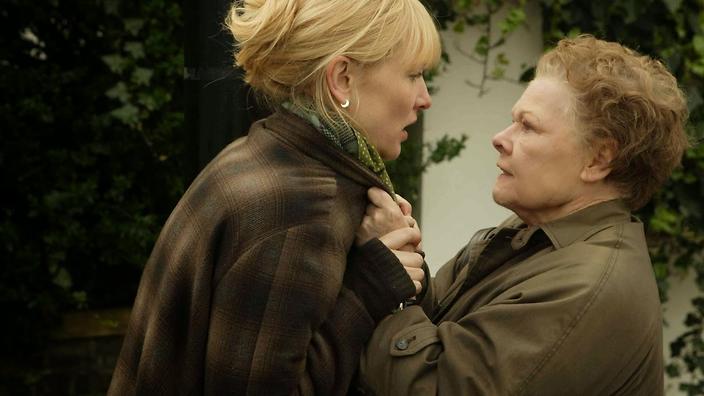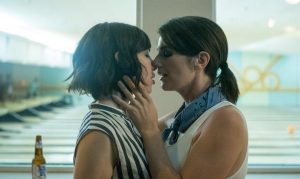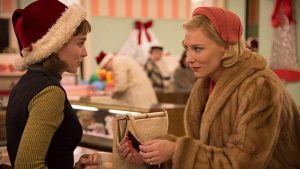Mad, criminal or straight: Female desire in film and TV

When it comes to representations of lesbians in film and television, sometimes they’re there, mostly they’re not. And if they are, they’re mostly confined to cells.
The lesbian in popular culture is usually mad, criminal or she’s really, actually, heterosexual. Think Charlize Theron’s stunning portrayal of serial killer Aileen Wournos in Monster, the crims we all love to watch in Prisoner, Wentworth and Orange is the New Black, and the ‘queer woman turned straight’ in The Kids Are Alright and Chasing Amy. We’ve also got the feminist archetype stitched up, too. You know, the ugly, man-hating, spinster with lots of cats. And to be honest, I’ve never met a lesbian like that – and I’ve met a lot. It’s not a pretty picture on the big screen or on TV, and it doesn’t have to be.

Syd (Carrie Brownstein) and Ali (Gaby Hoffmann) in Transparent. (Photo: Amazon Studios)
Statistically speaking, lesbian and bisexual women are more at risk than their heterosexual counterparts across a range of factors; we drink more, smoke more, have more orgasms (bisexuals have the least) and rarely leave the house (if you believe all the U-Haul jokes that season two of Transparent beautifully portray when Syd and Ali move in together).
But we’re also carrying the cultural baggage of being hauled off to the insane asylum back in 1900s when lesbian desire was seen as abnormal. That is, if we’re carrying anything at all, because there’s a double-edged sword when it comes to representations of lesbians in the public realm. Sometimes we’re there, mostly we’re not. And if we are, our most popular outings are confined to cells. A new study on diversity in entertainment on TV and in cinema found that female characters fill only 28.7 per cent of all speaking roles in film and less than 40 per cent in TV shows. Of the 11,194 speaking characters analysed, 49 were lesbian, 158 were gay, and 17 were bisexual. In terms of percentages, only 27.9 per cent of LGBT characters were female. So not only are we up against a gender gap, but also a combined sexuality and gender gap. Add race into the mix and 78.9 per cent of characters were white. Researcher Stacy Smith calls it an “inclusion crisis”. I call it devastating.
As a young lesbian, I searched far and wide through every TV show and movie I could wrap my eyes around to find myself reflected. I fell in love with The L Word in the early 2000s because there were lesbians everywhere; beautiful, white, successful, political, artistic, sexual, lesbians who I wanted to be. Sure, they may have popularised the idea of lesbian bed death – as if two women can’t possibly maintain desire for one another – and we rarely saw the characters actually having sex, but we knew they were doing it.
Arthouse movies were, and still are, my very best friend. But I’m a Cheerleader, I Can’t Think Straightand Room in Rome are my top three lesbian flicks. Carol is a newly added addition but the running theme maintains the narrative of forbidden desire, of illness, of abnormality, as did Cate Blanchett’s role in Notes on a Scandal where she enters into a relationship with a minor much to the disdain of the desirous and bitter lesbian character embodied by Judi Dench.

Therese Belivet (Rooney Mara) and Carol (Cate Blanchett) in Carol. (Photo: Transmission)
I’m not saying we need normal, because that’s just boring, but we need more diversity in how we represent lesbians on the screen. Transparent’s slew of same-sex attracted characters is a wonderful cameo in our need for more, but we need more than crims, mentally disturbed people and porn stars doing the work of representing who we are.
Gay men have made it into the mainstream with ground-breaking shows like Will and Grace and more recently Modern Family, Please Like Me and The Family Law. Bisexuals have had my other favourite TV show, Lost Girl, but even that is but a memory now. All of these shows, excluding The Family Law, are a virtual whitewash of representation. Ellen DeGeneres, through her original television sitcom and her talk show, is a beacon and a pioneer, but still a white one. Predominantly though, lesbian and bisexual characters are still loitering somewhere between the pages of history and the celluloid closet. The closet is dead so it’s time for us, like film theorist Sally R. Munt suggests, to “come in’. And come in not just to our own gay, lesbian, bisexual and transgender circles in order to write ourselves in, but to come into the community at large.
Originally published by SBS Sexuality.
